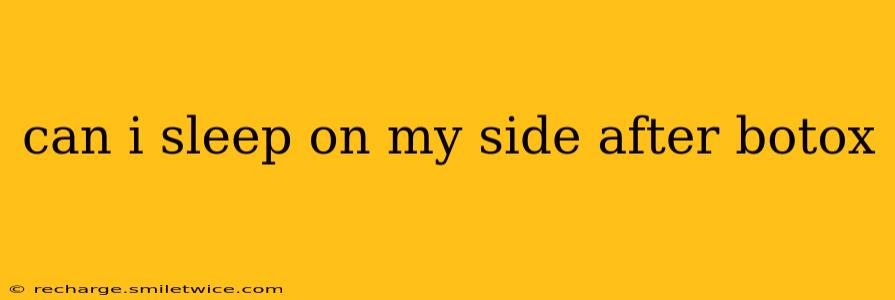Botox, a popular cosmetic treatment, is known for its ability to temporarily reduce wrinkles and fine lines. However, many patients wonder about the best post-procedure practices, particularly regarding sleep position. The question on many minds is: Can I sleep on my side after Botox? The short answer is: it depends. Let's delve into the specifics to ensure you achieve optimal results and minimize any potential complications.
What Happens During a Botox Treatment?
Before addressing sleep positions, it's crucial to understand what Botox actually does. Botox injections contain botulinum toxin type A, a neurotoxin that temporarily paralyzes the muscles where it's injected. This paralysis prevents the muscles from contracting, which in turn reduces the appearance of wrinkles. The effects typically begin to appear within a few days and last for several months.
Why Sleeping Position Matters After Botox
The immediate period after a Botox treatment is critical. Sleeping on the treated area can potentially:
- Displace the Botox: Pressure from your face against the pillow can redistribute the botulinum toxin, leading to uneven results or a less effective treatment.
- Cause Bruising or Swelling: While less common, sleeping on your face can increase the risk of bruising or swelling at the injection site.
- Reduce Efficacy: While less likely to significantly affect the results, applying pressure on the injected area could interfere with the toxin's absorption and diffusion into the muscle tissues.
Can I Sleep on My Side After Botox?
While you can technically sleep on your side after Botox, it's generally recommended to avoid it, at least for the first few nights. Sleeping on your back is the ideal position to minimize pressure on the treated areas. However, the level of caution and the duration depend largely on the areas treated and individual factors. For example, Botox in the forehead is less prone to displacement than Botox injected around the eyes or mouth.
How to Sleep After Botox to Maximize Results
To ensure optimal results from your Botox treatment, consider these recommendations:
- Sleep on your back: Elevate your head slightly with extra pillows to enhance comfort and drainage.
- Avoid side sleeping: This is especially important for the first 24-72 hours.
- Use a clean pillowcase: This helps prevent infection.
- Avoid strenuous activities: Postpone rigorous workouts or intense physical activity for the first few days to reduce swelling and bruising.
- Follow your doctor's instructions: Your doctor will provide specific post-treatment care recommendations tailored to your individual needs and treatment areas.
What if I Can't Sleep on My Back?
Many find sleeping on their back uncomfortable. If this is the case, try these alternatives:
- Use extra pillows: Create a supportive barrier to minimize pressure on your face.
- Sleep on your side, but use a special pillow: A specially contoured pillow designed for side sleepers can minimize face compression.
- Compromise: If you must sleep on your side, try to alternate sides throughout the night.
What Are the Signs of Botox Complications?
While rare, it’s crucial to be aware of potential complications. Contact your doctor immediately if you experience:
- Severe swelling or bruising: Unusually excessive swelling or bruising around the injection site.
- Drooping eyelids or eyebrows: Uneven or excessive relaxation of facial muscles.
- Difficulty swallowing or breathing: This is a rare but serious side effect and requires immediate medical attention.
- Persistent pain or numbness: Lingering pain or numbness in the treated area should be reported.
Conclusion
While sleeping on your side after Botox isn't strictly forbidden, it's best to avoid it, especially in the initial hours following the treatment. By adhering to these guidelines, sleeping on your back, and closely monitoring for any complications, you can help ensure optimal results and maximize the longevity of your Botox treatment. Remember to always consult your doctor for personalized advice and to address any concerns. Your health and well-being are paramount.
